What is Sedition? What is anti-national? What is offensive? In today’s context, our panelists looked at these contours of free speech 75 years after Independence
The Media Mahamanthan organised by Organiser and Panchjanya began with a discussion on “Media” and “Free Speech”—especially what it means in the contemporary context and the digital age and how far the concept has evolved in the last 75 years. The panelists included social media influencers, political activists and strong Hindu voices like Kapil Mishra, Malini Awasthi, Anshul Saxena, Shefali Vaidya, and Anand Ranganathan.
It has been 75 years since India got Independence from British rule, along with 75 years for both the Organiser and Panchjanya. So the country and these magazines have a shared history and evolution in a lot of ways. Editor Organiser, Prafulla Ketkar, began the discussion with the case of May 26, 1950, which led to an amendment in the newly formed Constitution in 1951. This amendment was triggered by two landmark judgments of the Supreme Court, which changed the contours of the freedom of speech and expression as it stands today. Organiser with Brij Bhushan as its publisher and KR Malkani as its editor was issued a notice in March 1950 under Section 7(1)(c). The majority judgment held that unless a law restricting freedom of speech and expression is directed solely against the undermining of the security of the State, such law cannot fall within the reservation under Article 19(2), although the restrictions which it seeks to impose may have been conceived generally in the interests of public order. (Bar&Bench)
Aftermath
The Constitution was amended in June 1951—within seventeen months of its coming into force and within thirteen months of the two judgments—by the Constituent Assembly itself. It amended Article 19(2) to include three new enumerated ‘reasonable restrictions’ to the right to free speech. These were “public order”, “friendly relations with foreign states”, and “incitement to an offence”.
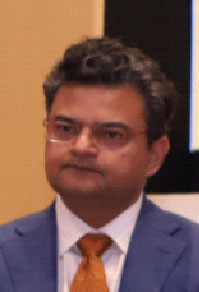
‘There are two types of tones in the country regarding free speech on social media. In a way, it can be said that one party has been given complete freedom in this matter while it is not so with the other side. Nowadays a lot is being talked about hate speech but which is hate speech and which is not? After all, who will decide this? In today’s era, different aspects are being treated differently for reacting on social media which is not right’ — Dr Anand Ranganathan
Prafulla Ketkar asked the panelists how they were navigating the “free speech” debate today, as it seems the struggle still continues, and maybe even more so in the double-edged social media age. What is sedition? What is anti-national? What is offensive? Let’s discuss that in this “panchayat” he said. Hitesh Shankar, the editor of Panchjanya, also talked about the unfortunate incident of Gandhiji’s assassination, which put censorship on the two weeklies soon after they started. He compared that time to today—when those who talk of our great “civilisation” and “sanskriti” are ironically considered intolerant and penalised.
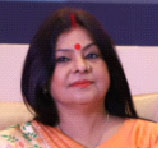
‘Social media is a double-edged sword. At present only the faith of Hindus is hurt and it is given the name of Freedom of Speech. However, the same attitude is not adopted in the case of other religions. Jokes are being made when a Shivling is found in the Gyanvapi mosque, but there is no violence of any kind, whereas if the same thing happens with any other religion, then the result is different’ — Malini Awasthi
That’s when folk singer and Hindu cultural icon Malini Awasthi joined in and talked about how positive Indian terms—like Bhakt and Sanghi—are being used in a derogatory manner, changing their meaning, to attack those who are proud of their Hindu roots. She narrated an incident when author Mrinal Pandey made fun of Karwachauth on Twitter, leaving her flabbergasted; to which Kapil Mishra added how those who attack Karwachauth more often than not support the Hijab, exposing their pseudo feminism and hypocrisy.
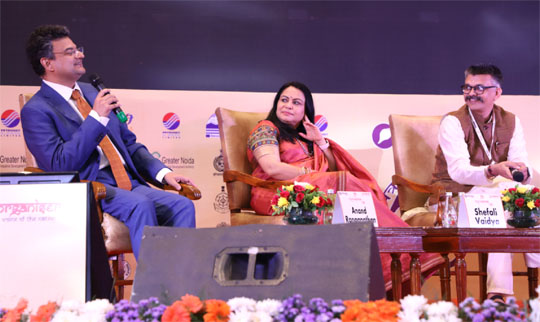
Malini agreed that social media has exposed a lot of these cultural voices who have carefully constructed their intellectual, liberal, and tolerant image for decades as they are extremely intolerant when it comes to Hindus celebrating their faith.
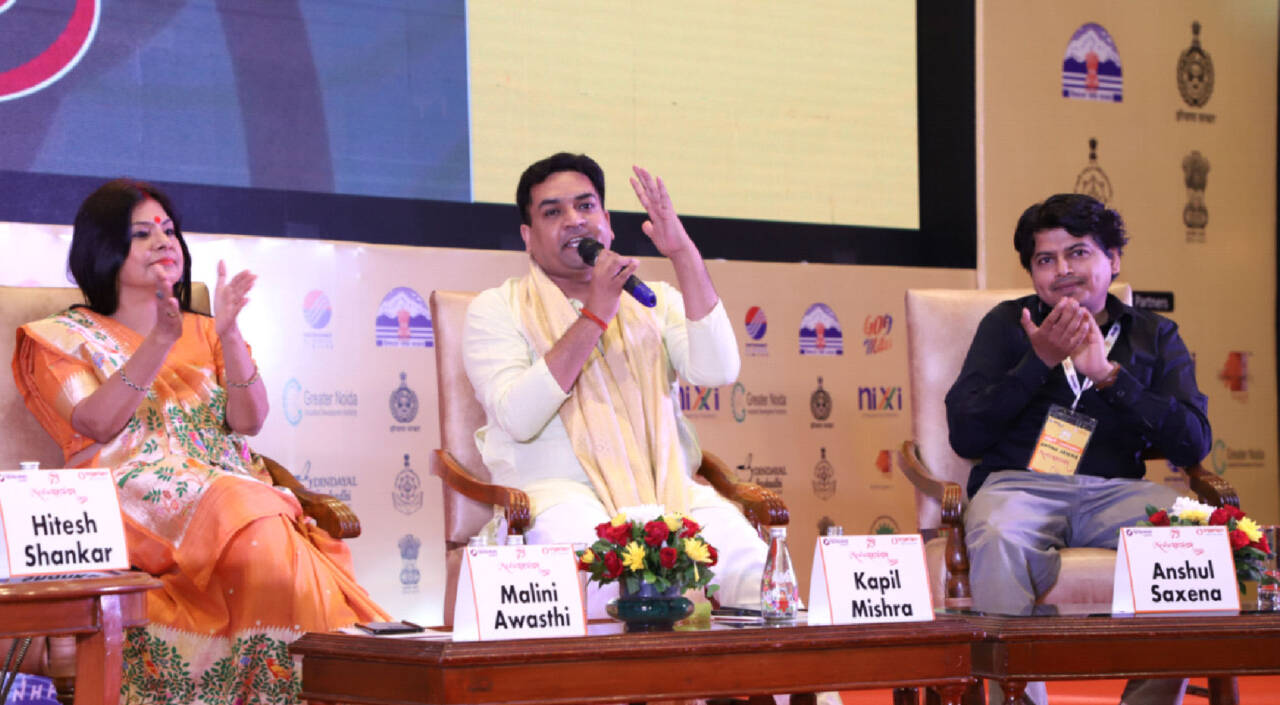
Introducing Anand Ranganathan, as a “free speech absolutist or terrorist”, Prafulla Ketkar asked him if he wishes for “limitless free speech” or does he believe in certain limitations as listed under the Constitution. He replied, how he’s a “man of black and white, and grey allows people to hide their hypocrisy”. “If freedom is subject to any thing then it’s not freedom”. If you stand with Salman Rushdie, Charlie Hebdo, then you have to stand with Ratan Lal (the DU professor who ridiculed the discovery of Shivling at Gyanvapi) too. Talking of “Gustakhe Rasool” he said how a law couldn’t be a deterrent against intolerance or aggression by anybody who might take offence.Kapil Mishra, congratulating the Organiser said, how for the magazine it has not only been 75 years of journalism but also 75 years of keeping journalism alive. He took a dig at Rahul Gandhi for saying “India is a union of States” in Britain, adding, “The same Britain who came to India with their East India Company in 1857, knowing very well that this nation—India—exists on an ideology that binds it and makes it unique.” Reciting a poem on what “Azaadi” is in the contemporary context, he said how the so-called majority is often marginalised, attacked and victimised. Citing instances of Bengal, Maharastra, and Delhi—he said freedom of speech seems to be reserved only to appease the minority in this country.
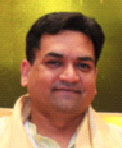
‘The Yuvraj of the country’s oldest party can go to London and abuse Mother India, they can say that India is not a nation, but it all comes under Freedom of Speech. Here those opposing Karva Chauth come in support of hijab. Here there is the freedom to insult Shivling, there is the freedom to lift BJP leaders like Bagga from home’ — Kapil Mishra
Shefali Vaidya, Hindu activist and author, and possibly receiver of the worst of trolling on Twitter, also agreed with Mishra. She said Free speech should be checked personally and is very subjective. However, she does feel that the state machinery, especially in Maharashtra, is constantly biased against the Hindus. She narrated how she’s constantly attacked for writing an “Upanyas” on Aurangzeb—an intolerant invader who killed greats like Guru Tegh Bahadur. “Does free speech only apply to critiquing and attacking Hindus? Why is Aurangzeb’s grave protected by state? Can this happen to Hitler in Israel?” she asked.
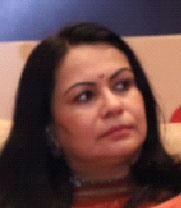
‘We have to think for ourselves about what we are saying, what facts we are saying. Those who were questioning the arrest of Prashant Kanojia, are silent today when a young woman has been arrested for sharing a post in Maharashtra. What kind of freedom of speech is this, which is decided on the basis of the region. In Maharashtra, the tomb of Aurangzeb is being guarded by the police while the people running the government in the state keep taking Shivaji’s name. Why this hypocrisy? Where is the Freedom of Speech in Bengal, Rajasthan and Tamil Nadu? We need to introspect ourselves’ — Shefali Vaidya
Anshul Saxena, who has 1 million followers on Twitter, joined the discussion. He said that there are many kinds of free speech and many platforms with their own criteria. Though mostly even the founders of these social media platforms have agreed that they are Left-leaning, being an opposite voice is also a struggle to survive and navigate these platforms. He talked of the platform bias, as shown in the recent pandemic. He said the platforms were full of imagery of Indian crematoriums—not giving dignity of death to Hindus. Still, when by accident, a media house had published a picture of a Muslim man getting an RTPCR test, it became an issue for representation purposes. He said that even stand-up comedians who consider themselves self-appointed custodians of free speech usually only attack the Hindu faith. He said how with freedom of speech comes responsibility, and all faiths should be shown equal sensitivity.
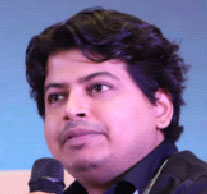
‘During the Corona period, visuals and pictures of the funeral were shown a lot, but after the pictures of the corona test of Muslims came, people’s feelings were getting hurt. How is it possible? If we talk about Freedom of Speech, then all sides should be treated equally’ — Anshul Saxena
Anand Ranganathan concluded with how Hindus are being treated as second class citizens in this country by the judiciary and government’s selective silence on issues like control of Hindu Temples, Sabarimala Judgement etc. and how “free speech” means different things for different communities.


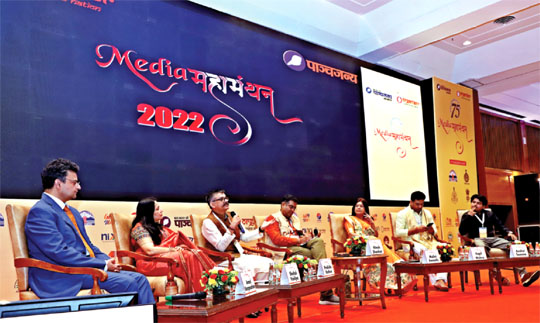










Comments